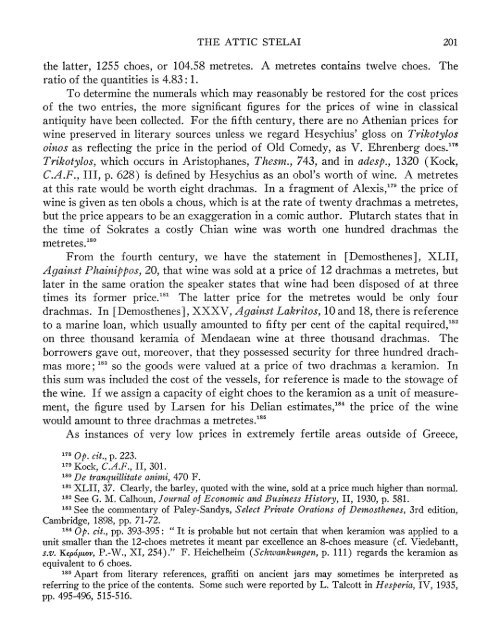the attic stelai - The American School of Classical Studies at Athens
the attic stelai - The American School of Classical Studies at Athens
the attic stelai - The American School of Classical Studies at Athens
Create successful ePaper yourself
Turn your PDF publications into a flip-book with our unique Google optimized e-Paper software.
THE ATTIC STELAI 201<br />
<strong>the</strong> l<strong>at</strong>ter, 1255 choes, or 104.58 metretes. A metretes contains twelve choes. <strong>The</strong><br />
r<strong>at</strong>io <strong>of</strong> <strong>the</strong> quantities is 4.83: 1.<br />
To determine <strong>the</strong> numerals which may reasonably be restored for <strong>the</strong> cost prices<br />
<strong>of</strong> <strong>the</strong> two entries, <strong>the</strong> more significant figures for <strong>the</strong> prices <strong>of</strong> wine in classical<br />
antiquity have been collected. For <strong>the</strong> fifth century, <strong>the</strong>re are no A<strong>the</strong>nian prices for<br />
wine preserved in literary sources unless we regard Hesychius' gloss on Trikotylos<br />
oinos as reflecting <strong>the</strong> price in <strong>the</strong> period <strong>of</strong> Old Comedy, as V. Ehrenberg does.178<br />
Trikotylos, which occurs in Aristophanes, <strong>The</strong>sm., 743, and in adesp., 1320 (Kock,<br />
C.A.F., III, p. 628) is defined by Hesychius as an obol's worth <strong>of</strong> wine. A metretes<br />
<strong>at</strong> this r<strong>at</strong>e would be worth eight drachmas. In a fragment <strong>of</strong> Alexis,179 <strong>the</strong> price <strong>of</strong><br />
wine is given as ten obols a chous, which is <strong>at</strong> <strong>the</strong> r<strong>at</strong>e <strong>of</strong> twenty drachmas a metretes,<br />
but <strong>the</strong> price appears to be an exagger<strong>at</strong>ion in a comic author. Plutarch st<strong>at</strong>es th<strong>at</strong> in<br />
<strong>the</strong> time <strong>of</strong> Sokr<strong>at</strong>es a costly Chian wine was worth one hundred drachmas <strong>the</strong><br />
metretes.180<br />
From <strong>the</strong> fourth century, we have <strong>the</strong> st<strong>at</strong>ement in [Demos<strong>the</strong>nes], XLII,<br />
Against Phainippos, 20, th<strong>at</strong> wine was sold <strong>at</strong> a price <strong>of</strong> 12 drachmas a metretes, but<br />
l<strong>at</strong>er in <strong>the</strong> same or<strong>at</strong>ion <strong>the</strong> speaker st<strong>at</strong>es th<strong>at</strong> wine had been disposed <strong>of</strong> <strong>at</strong> three<br />
times its former price.181 <strong>The</strong> l<strong>at</strong>ter price for <strong>the</strong> metretes would be only four<br />
drachmas. In [Demos<strong>the</strong>nes], XXXV, Against Lakritos, 10 and 18, <strong>the</strong>re is reference<br />
to a marine loan, which usually amounted to fifty per cent <strong>of</strong> <strong>the</strong> capital required,182<br />
on three thousand keramia <strong>of</strong> Mendaean wine <strong>at</strong> three thousand drachmas. <strong>The</strong><br />
borrowers gave out, moreover, th<strong>at</strong> <strong>the</strong>y possessed security for three hundred drachmas<br />
more; 183 So <strong>the</strong> goods were valued <strong>at</strong> a price <strong>of</strong> two drachmas a keramion. In<br />
this sum was included <strong>the</strong> cost <strong>of</strong> <strong>the</strong> vessels, for reference is made to <strong>the</strong> stowage <strong>of</strong><br />
<strong>the</strong> wine. If we assign a capacity <strong>of</strong> eight choes to <strong>the</strong> keramion as a unit <strong>of</strong> measurement,<br />
<strong>the</strong> figure used by Larsen for his Delian estim<strong>at</strong>es,184 <strong>the</strong> price <strong>of</strong> <strong>the</strong> wine<br />
would amount to three drachmas a metretes.185<br />
As instances <strong>of</strong> very low prices in extremely fertile areas outside <strong>of</strong> Greece,<br />
178 op. cit., p. 223.<br />
179 Kock, C.A.F., II, 301.<br />
180De tranquillit<strong>at</strong>e animi, 470 F.<br />
181 XLII, 37. Clearly, <strong>the</strong> barley, quoted with <strong>the</strong> wine, sold <strong>at</strong> a price much higher than normal.<br />
182<br />
See G. M. Calhoun, Journal <strong>of</strong> Economic and Business History, II, 1930, p. 581.<br />
183<br />
See <strong>the</strong> commentary <strong>of</strong> Paley-Sandys, Select Priv<strong>at</strong>e Or<strong>at</strong>ions <strong>of</strong> Demos<strong>the</strong>nes, 3rd edition,<br />
Cambridge, 1898, pp. 71-72.<br />
184<br />
op. cit., pp. 393-395: " It is probable but not certain th<strong>at</strong> when keramion was applied to a<br />
unit smaller than <strong>the</strong> 12-choes metretes it meant par excellence an 8-choes measure (cf. Viedebantt,<br />
s.v. Kepacptov, P.-W., XI, 254)." F. Heichelheim (Schwankungen, p. 111) regards <strong>the</strong> keramion as<br />
equivalent to 6 choes.<br />
185Apart from literary references, graffiti on ancient jars may sometimes be interpreted as<br />
referring to <strong>the</strong> price <strong>of</strong> <strong>the</strong> contents. Some such were reported by L. Talcott in Hesperia, IV, 1935,<br />
pp. 495-496, 515-516.
















